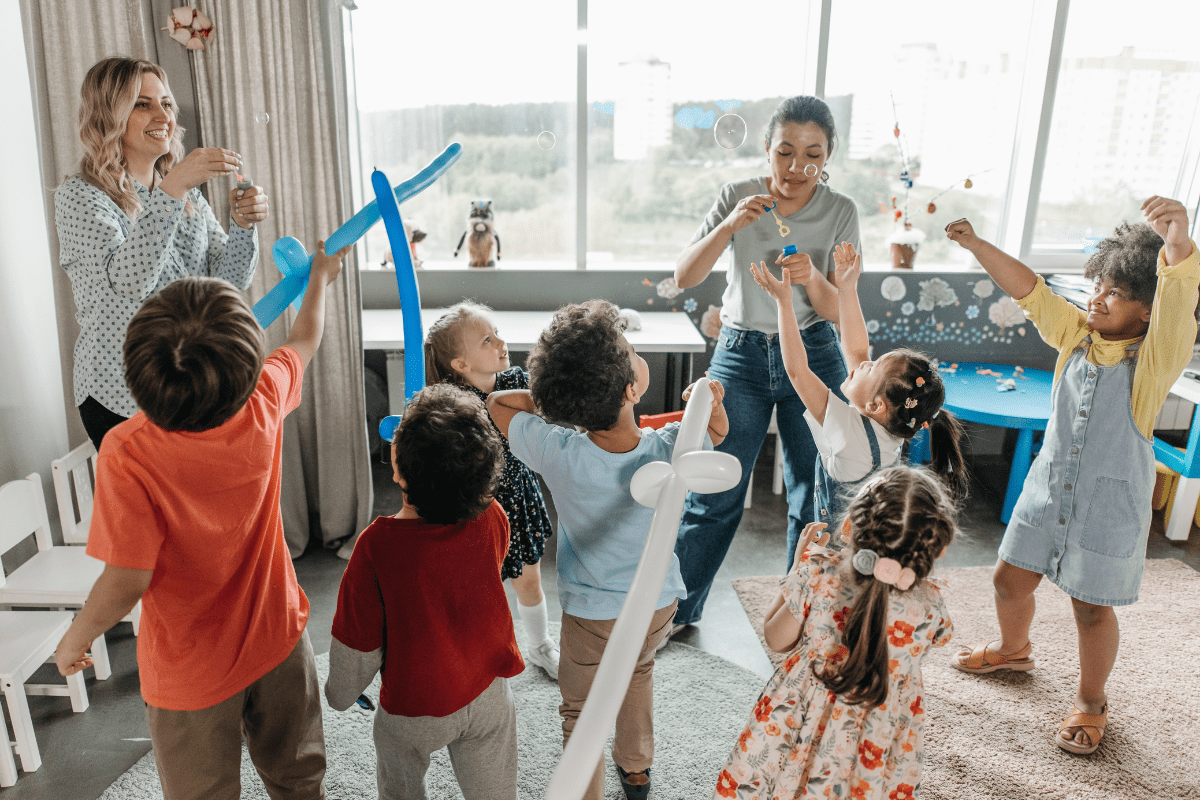
Looking for ways to keep your preschooler engaged and learning at home? Early childhood is the most crucial phase for brain development, and the right activities can spark creativity, enhance memory, and build important life skills. Whether you’re homeschooling or just want to boost your child’s cognitive abilities during playtime, this guide brings you 25 smart preschool activities that are fun, educational, and easy to do at home.
During the preschool years (ages 3–5), a child’s brain forms over 1 million neural connections per second according to Harvard’s Center on the Developing Child. This rapid development period makes it the optimal time for skill acquisition, and research shows that high-quality early learning experiences directly correlate with improved academic performance and emotional intelligence later in life.
Materials Shopping List
Basic Supplies:
- Play dough ingredients (flour, salt, water, food coloring)
- Sensory materials (rice, pasta, sand, beans)
- Art supplies (paper plates, construction paper, crayons, markers)
- Household items (sponges, cups, bowls, magnets, ice trays)
- Safety equipment (child scissors, non-toxic materials, towels for cleanup)
Optional Enhancements:
- Letter and number flashcards
- Small toys for sensory bins
- Musical instruments or device for music activities
- Magnifying glass for exploration activities
15 Smart Activities by Age Group
Easy Level (Ages 3-4)
1. Sensory Bins
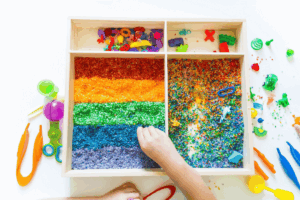
Fill containers with rice, pasta, or dried beans for tactile exploration. Add small toys, measuring cups, and different textured tools to create an engaging sensory experience that enhances fine motor skills and sensory processing abilities.
- Materials: Large container, rice/pasta, small toys, scoops
- Skills Developed: Fine motor skills, sensory processing, hand-eye coordination
- Brain Boost: Builds neural pathways in the somatosensory cortex
- Time Needed: 10-15 minutes
- Mess Level: Medium – lay down towels
- Fun Factor: High giggles guaranteed from texture exploration
- ⚠️ Safety: Supervise closely to prevent ingestion of small items
2. Color Sorting Games
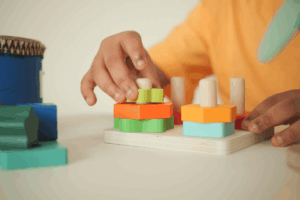
Use safe, large objects like blocks or toys to sort by color into different containers. This simple activity builds visual discrimination and categorization skills while teaching children to identify patterns and make logical connections between objects.
- Materials: Colored blocks/toys, sorting containers or colored paper circles
- Skills Developed: Visual discrimination, categorization, pattern recognition
- Brain Boost: Strengthens visual processing areas in the occipital lobe
- Time Needed: 5-10 minutes
- Mess Level: Low – easy cleanup
- Fun Factor: Satisfying organization and achievement feeling
- ⚠️ Safety: Use objects larger than child’s fist to prevent choking
3. Shape Hunt Around the House

Turn learning shapes into an exciting adventure around your home. Ask “Can you find something that’s a circle?” and explore together, helping children develop spatial awareness and observational skills while making learning fun and memorable.
- Materials: Shape cards or pictures, clipboard for recording finds
- Skills Developed: Spatial awareness, observation, shape recognition
- Brain Boost: Activates spatial reasoning networks in the parietal lobe
- Time Needed: 15-20 minutes
- Mess Level: None – just exploring
- Fun Factor: Adventure excitement of discovery
- ⚠️ Safety: Establish safe exploration areas and accompany your child
4. Matching Socks Game

Give a pile of different socks for your child to match into pairs. Start with obvious differences in color before progressing to subtle patterns, helping children develop attention to detail and systematic thinking through this familiar household activity.
- Materials: Collection of clean socks in various colors and patterns
- Skills Developed: Visual perception, pattern recognition, systematic thinking
- Brain Boost: Enhances pattern recognition networks in the temporal lobe
- Time Needed: 10-15 minutes
- Mess Level: None – uses everyday items
- Fun Factor: Satisfaction of making perfect pairs
- ⚠️ Safety: Use clean socks without small attachments or decorations
5. Animal Walks

Practice different animal movements like hopping like a bunny, crawling like a bear, or slithering like a snake. Demonstrate each movement first, then encourage creative interpretations that strengthen gross motor coordination while bringing lots of joyful laughter.
- Materials: Open space, animal picture cards (optional)
- Skills Developed: Gross motor coordination, body awareness, creativity
- Brain Boost: Develops motor cortex and cerebellar coordination
- Time Needed: 10-15 minutes
- Mess Level: None – just movement
- Fun Factor: Lots of laughter and silly movements
- ⚠️ Safety: Clear area of obstacles and provide soft flooring
Intermediate Level (Ages 4-5)
6. Story Building with Picture Cards
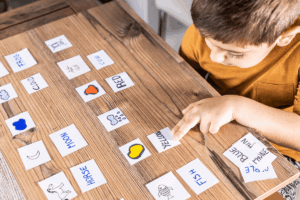
Use diverse image flashcards to encourage creative story creation. Start with 3-4 cards and gradually increase complexity as skills develop, helping children learn story structure, cause-and-effect relationships, and creative problem-solving while building confidence in communication.
- Materials: Image flashcards or magazine pictures, recording device (optional)
- Skills Developed: Narrative thinking, vocabulary expansion, creativity
- Brain Boost: Activates language centers in Broca’s and Wernicke’s areas
- Time Needed: 15-20 minutes
- Mess Level: None – just storytelling
- Fun Factor: Imagination unleashed through creative narratives
- ⚠️ Safety: Use cards with rounded edges and supervise small parts
7. DIY Play Dough Creations
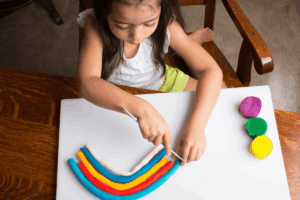
Mix flour, salt, and water to create safe, homemade play dough. Add natural food coloring for visual appeal and let children create animals, shapes, or imaginative sculptures that boost creativity, fine motor skills, and three-dimensional thinking while strengthening hand muscles for writing preparation.
- Materials: Flour, salt, water, food coloring, cookie cutters, rolling tools
- Skills Developed: Creativity, fine motor skills, three-dimensional thinking
- Brain Boost: Enhances creativity networks and strengthens motor cortex pathways
- Time Needed: 20-30 minutes
- Mess Level: High – have cleanup supplies ready
- Fun Factor: Squishing and creating satisfaction
- ⚠️ Safety: Ensure all ingredients are non-toxic and supervise to prevent consumption
8. Number Hopscotch
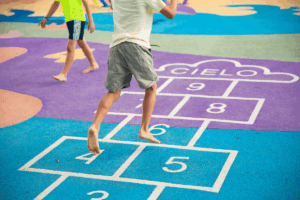
Draw large numbers on safe tiles or paper for hopping activities. Call out numbers for children to jump to in sequence or randomly, enhancing number recognition while building gross motor skills and reinforcing learning through multiple sensory channels simultaneously.
- Materials: Chalk or paper numbers, safe jumping area
- Skills Developed: Number recognition, gross motor skills, sequencing
- Brain Boost: Integrates mathematical concepts with motor skill development
- Time Needed: 10-15 minutes
- Mess Level: None – just jumping
- Fun Factor: Active learning with physical challenges
- ⚠️ Safety: Ensure non-slip surfaces and clear landing areas
9. Water Transfer Game
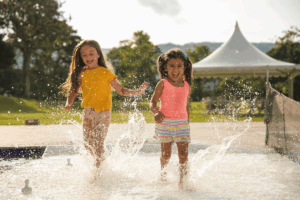
Set up stations with different containers for transferring water safely. Use sponges, small cups, and various sized bowls for exploration that builds focus, hand-eye coordination, and introduces science concepts while providing calming, therapeutic sensory benefits.
- Materials: Sponges, cups, bowls, towels, aprons or old clothes
- Skills Developed: Focus, hand-eye coordination, scientific concepts
- Brain Boost: Develops fine motor control and scientific reasoning skills
- Time Needed: 15-20 minutes
- Mess Level: Very high – use waterproof area
- Fun Factor: Splashing joy and water play satisfaction
- ⚠️ Safety: Use shallow water only and supervise closely at all times
10. Nature Collage

Collect safe natural materials during outdoor walks or garden exploration. Create artistic collages using leaves, flowers, and other natural treasures that build sensory connection with the environment while developing artistic expression and encouraging observation skills and scientific curiosity.
- Materials: Collection bag, glue, paper, leaves, flowers, twigs
- Skills Developed: Artistic expression, nature connection, observation
- Brain Boost: Connects sensory processing with creative expression centers
- Time Needed: 20-30 minutes
- Mess Level: Medium – glue and natural materials
- Fun Factor: Using outdoor treasures for indoor art
- ⚠️ Safety: Identify safe plants and avoid thorns, poisonous plants, or insects
Advanced Level (Ages 5+)
11. Alphabet Treasure Hunt
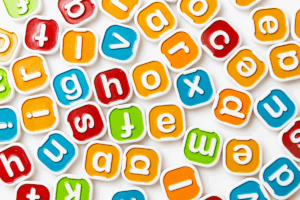
Hide letter cut-outs around safe areas of your house systematically. Ask children to find letters in alphabetical order or spell simple words, combining physical movement with essential literacy skill development while making learning letters exciting and memorable.
- Materials: Letter cut-outs, hiding spots, alphabet chart for reference
- Skills Developed: Letter recognition, physical movement, problem-solving
- Brain Boost: Strengthens letter recognition and phonological awareness pathways
- Time Needed: 15-25 minutes
- Mess Level: Low – just hiding and finding
- Fun Factor: Detective excitement and treasure hunting
- ⚠️ Safety: Hide letters in safe, accessible locations only
12. Building Blocks Challenges
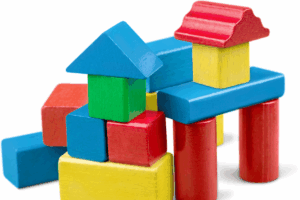
Challenge children to build specific objects like towers, bridges, or animals. Start with simple structures and gradually increase complexity, helping develop logical thinking and spatial problem-solving skills while teaching engineering concepts and building persistence and focus.
- Materials: Various building blocks, challenge cards, timer (optional)
- Skills Developed: Logical thinking, spatial problem-solving, engineering concepts
- Brain Boost: Strengthens spatial reasoning and problem-solving neural networks
- Time Needed: 20-30 minutes
- Mess Level: Medium – blocks scattered during play
- Fun Factor: Construction pride and achievement satisfaction
- ⚠️ Safety: Use age-appropriate blocks without small detachable parts
13. Emotion Faces with Paper Plates
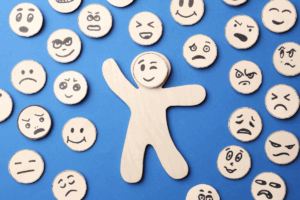
Draw different emotions on paper plates and discuss each feeling thoroughly. Use mirrors to practice making the expressions themselves, supporting crucial emotional learning and empathy development while making abstract emotional concepts concrete and understandable.
- Materials: Paper plates, markers, mirrors, emotion picture books
- Skills Developed: Emotional intelligence, empathy, self-awareness
- Brain Boost: Develops emotional intelligence and social cognition skills
- Time Needed: 15-20 minutes
- Mess Level: Low – just drawing materials
- Fun Factor: Mirror practice and silly face making
- ⚠️ Safety: Use non-toxic markers and supervise any cutting activities
14. Indoor Obstacle Course

Create challenging but safe obstacle courses using household furniture items. Include crawling, jumping, balancing, and coordination challenges that improve balance, planning skills, and gross motor development while building confidence in physical abilities and enhancing executive functioning.
- Materials: Chairs, pillows, tape, cones or markers, timer
- Skills Developed: Balance, planning skills, gross motor development
- Brain Boost: Integrates motor planning with executive function development
- Time Needed: 20-30 minutes
- Mess Level: Medium – furniture rearrangement needed
- Fun Factor: Ninja training and physical challenges
- ⚠️ Safety: Remove sharp edges, secure loose items, and supervise actively
15. DIY Puppet Show
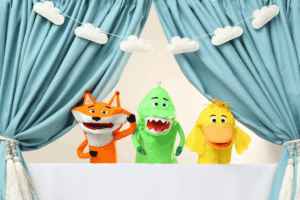
Create puppets using socks or paper bags with creative decorations. Help children develop stories and perform shows for family audiences, greatly building confidence, storytelling abilities, and creative expression while enhancing imagination and communication skills naturally.
- Materials: Socks, paper bags, markers, small stage area, audience seating
- Skills Developed: Confidence, storytelling, creative expression, communication
- Brain Boost: Enhances creativity, language development, and social confidence
- Time Needed: 30-45 minutes
- Mess Level: Medium – craft materials and performance setup
- Fun Factor: Broadway dreams and performance excitement
- ⚠️ Safety: Supervise small decorative parts and ensure safe performance area
Safety Guidelines
General Safety Considerations:
- Always supervise activities involving small objects, water, or potential mess
- Use non-toxic, age-appropriate materials exclusively
- Keep first aid supplies accessible during all activities
- Test all materials for allergies before use
- Have cleanup supplies ready before starting any activity
Tips for Success
Making Activities Work:
- Start with activities matching your child’s current ability level
- Keep sessions short (10-30 minutes) to match attention spans
- Use positive reinforcement and celebrate effort over perfection
- Follow your child’s interests and energy levels
- Rotate activities regularly to maintain novelty and engagement
- Create a dedicated, safe learning space that’s easily accessible
